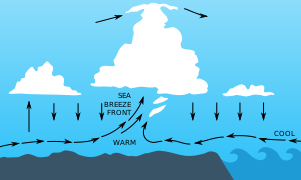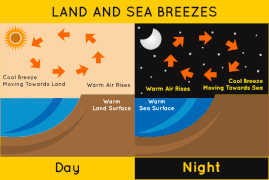Land and Sea Breeze - Definitions, Diagram, Facts, FAQs
Breezes play an important role in maintaining the coastal area temperature. The two types of breezes are land breeze and sea breeze. These are formed due to the temperature differences on the coastal side. Heat transfer happens in both sea and land breezes. In this article, we will discuss what is land breeze, what is sea breeze, factors affecting land and sea breezes, the advantages of land and sea breeze and sea breezes, the effects of land and sea breezes, and the difference between land and sea breezes.
This Story also Contains
- What is Breeze
- What is Land Breeze
- Advantages Of Land Breeze
- Factors Affecting Land Breeze
- What is Sea Breeze
- Advantages of Sea Breeze
- Factors Affecting Sea Breeze
- Difference Between Land and Sea Breeze

What is Breeze
Breeze meaning- A light wind.
On a hot early afternoon, take a walk along a dry beach. You start hopping and jumping as soon as your bare feet touch the sand and sprint towards the sea to cool off. Yes, the sun warms them both up. Land and water, on the other hand, do not heat and cool at the same rate. Breezes form in coastal areas as a result of the differential heating and cooling of land and water.
Types of breeze
- Land Breeze
- Sea Breeze
What is Land Breeze
Land Breeze definition: When the sun sets, both the land and the sea begin to cool. Because the land has a lower heat capacity than the sea, it cools off faster. As a result of the higher temperature above the water compared to the land, a low-pressure condition develops over the sea. As a result, air rushes from the land to the sea, resulting in the land breeze. This process continues throughout the night, and then the above-mentioned process is reversed.

Land breezes can happen at any time of year, although they're more common in the fall and winter when water temperatures are still warm and nights are cool. The land wind is a nighttime coastal breeze that blows from land to sea. The contrast in cooling rates between the land and the ocean causes it. The stronger the wind is, once again, the greater the temperature difference between the two.
The land gets heated faster than the sea, so the air on the land rises and moves towards the sea and the cool air in the sea moves towards the land to 'occupy the space' above the land.
Advantages Of Land Breeze
A land breeze or an offshore breeze, on the other hand, is the result of rivers drying land faster than water, and after sunset, the sea breeze diminishes and the wind then moves from land to sea. Sea breezes are most essential in coastal areas with prevailing winds.
Other advantages are:
- Natural air circulation
- Cooling effect on coastal water
- Moderation of coastal temperature at night
Factors Affecting Land Breeze
- Temperature difference
- Variation of pressure
- Speed and direction of the wind
- Geographic location
- Humidity
|
Related Topics, |
What is Sea Breeze
Sea breeze definition: The sea breeze is the movement of air from the sea to the land. The sun heats both the sea and the land's surface. Because the sea has a far higher heat capacity than the land, it heats up more slowly. As a result, the temperature above the ground surface rises, warming the surrounding air. Expansion happens in the less dense warm air, resulting in the formation of a low-pressure zone over the continent. A high-pressure area forms on the sea's surface at the same moment. The air flows from the high pressure over the sea to the low pressure over the land because of the pressure difference. This procedure is repeated throughout the day.

On hot, bright days in the spring and summer, the sea breeze is stronger. As a result, you'll notice a substantial temperature drop and an outstanding cooling impact. Because land and water heat at different rates, sea breezes occur during hot summer days. The land surface heats up faster than the sea surface during the day. The cooler air over the ocean flows across the land surface to replace the rising warm air as the warm air over the land rises.
The sea breeze can bring relief from oppressive heat, produce thunderstorms, provide moisture for fog, and improve or degrade air quality near the Earth's surface.
Advantages of Sea Breeze
Sea breezes are incredibly relaxing. That sea breeze smells wonderful for many reasons than just the promise of leisure. Sea air contains iodine, salt, and magnesium, which can help with asthma symptoms, respiratory health, allergies, and skin problems, as well as stimulate the immune system. The drive to get things done.
Other advantages are:
- Improved air quality
- Cooling of land
- Improves wind patterns for sailing
Factors Affecting Sea Breeze
- Difference in temperature
- Pressure difference
- Time of day
- Topography
- Cloud cover
Difference Between Land and Sea Breeze
The differences between land and sea breeze are given in the table below:
| Land Breeze | Sea Breeze |
| Air flows from land to sea during the night. | Air flows from sea to land during the day. |
| Land cools down faster than water at night. | Land heats up faster than water during the day. |
| Occurs at night or early morning. | Occurs during the day, especially in the afternoon. |
| Wind flows from land (high pressure) to sea (low pressure). | Wind flows from sea (high pressure) to land (low pressure). |
| Cooler land and relatively warmer sea. | Warmer land and relatively cooler sea. |
| Generally weaker than a sea breeze. | Stronger and more noticeable than a land breeze. |
| Short-lived and limited to nighttime hours. | Can last throughout the day until sunset. |
| Helpful in fishing as it cools the sea surface. | Brings cool air inland, providing relief from the heat. |
Also read:
Frequently Asked Questions (FAQs)
A land breeze is a wind that travels from the land to the sea. Land winds are most common at night since the sun only heats land surfaces to a depth of a few inches during the day. Because water has a high heat capacity, it will retain more heat at night than terrestrial surfaces.
The sea breeze is caused by the wind blowing from higher pressure over the water to lower pressure over the land. The strength of the sea wind will be determined by the temperature difference between the land and the water. The roles are reversed at night. The air above the sea has become warmer than the air above the land.
Because the water has a higher heat capacity than land, the sea's surface warms up more slowly than the land's surface. The land heats the air above it by convection as the temperature of the surface rises.
The difference in temperature between land and ocean bodies causes the land and sea breezes. These are primarily found along the coast. The movement of wind from land to sea is known as land breeze, while the movement of wind from sea to land is known as sea breeze. Land heats and cools at a faster rate than water.
Convection is the cause of land and sea breezes. The temperature of the land rises faster than that of the sea on a hot day.
Land breezes are weaker than sea breezes, however this is not due to temperature differences. Because daytime heating and nighttime cooling occur at roughly the same rate, both land and sea breezes have the potential to have the same strength.
